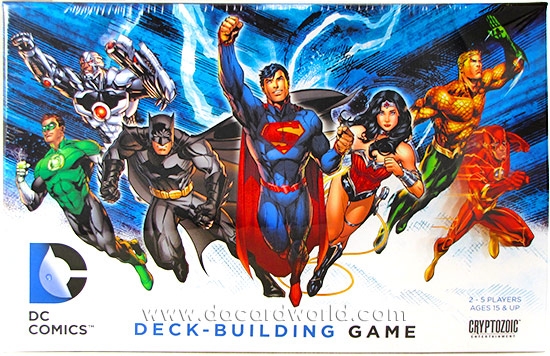
GAME DESCRIPTION: DC Comics Deck-Building Game is a *cough* deck builder designed for 2 to 5 players. It was created in 2012 by Criptozoic Entertainment. Players take the role of 1 of 7 different DC heroes, from Superman to Aquaman to Cyborg. Players attempt to build the ideal deck to defeat the revealed villain, and do so by adding powerful cards, destroying their weaker cards, and preventing your opponent from doing the same. The victor is the player with the most Victory Points when the last villain is defeated.
SET UP: Each player starts by randomly selecting a hero card. Each hero has a unique special ability. Each player starts with a deck 7 Punch cards and 3 Vulnerability cards. During the players turn, they draw 5 cards. The main deck is shuffled, and 5 cards are dealt face-up in a row called the "Line-up" There is also a Super-villain deck, that's shuffled, but the card Ra's Al Ghul is placed face-up on top first.
POWER: Every card, save for Punch and Vulnerability, has a number in the bottom right called the cost. Certain cards have a term called Power. On your turn, you can play as many cards as you want from your hand, and buy any amount of the cards in the Line-Up, from the Kick pile equal to or less than the amount of Power you have. The cost is subtracted from your current Power, and the card is placed in your discard pile. At the end of your turn, discard your hand and draw back up to 5 cards. If there aren't enough cards in your deck, shuffle the discard pile and use it as the deck.
SUPER-VILLAINS: At any point during your turn, you can pay the current Super-Villains cost to defeat them if you have enough Power. Doing so causes the Super-Villain to be placed in your discard pile, and the turn ends. The current player discards their hand, draws back up to five, and the next Super-Villain is flipped. Each Super-Villain will have an effect called First Appearance - Attack. When the character is flipped up, apply that effect as an Attack. If a Super-Villain is played from a players deck, this effect is no longer applicable.
FIGHTING: Certain Villain cards have an additional effect called led Attack. This is applied when played, and can do things to mess with the opponent, such as discarding or destroying (i.e. removing them permanently) cards. If you have a Hero card with Defense, you can play it to avoid the Attack card. Special rules to note:
- If you fail to land an Attack, this does not cancel out the cards other effects. It only prevents the cards Attack effect from applying
- Only the Hero's Defense effect is applied when being Attacked. Any other effects written are not applied during defense.
- Defense effects on Hero cards are only applied when being Attacked, and no other time.
LOCATION: There are Location cards, each representing a different place in the DC Universe. When a Location is played, it will stay permanently in front of the player, and only applies to that player. Every Location card also has an effect which can be applied if conditions are met.

VICTORY POINTS: VP is located in the star in the bottom left of every card. When the last Super-Villain is defeated, players tally up all the VP in their hand, deck, and discard pile. The player with the most
GAINING AND DESTROYING: Some cards have an effect which allow them to gain a certain card from the Line-Up, avoiding the cost required to obtain it. Other cards allow you to Destroy cards. This removes them from the game permanently, being placed neither in any players deck, nor the main deck.
CONCLUSION: I'm a big lover of card games, and comic books, so I may be a *little* biased. However, I really enjoyed this game. Since it was the first Deck Builder I played, I didn't have much to compare to for a while. Now, after playing a few others, it's still one of the best that I would recommend. In addition, there's also various expansions and other versions to try out, ,and mix up the regular game. With the strong theme, solid mechanics, and wide amount of versions to try, you'll find a lot to like about this game.





